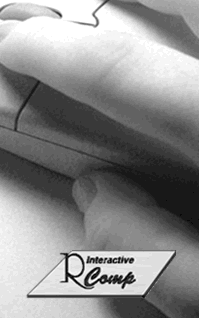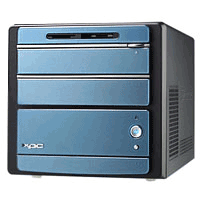

Standard RISCube
High Spec RISCube
RISCube Ultra
RISCube64-X2
RISCube Ultra Duo
RISCube Mini
Standard SpaceCube
High Spec SpaceCube
RISCBook
RISCBook+
RISCBook+ SE
Two computer platforms
Two processor cores
One small, smart box

The background to our RISCube and SpaceCube machines can be found elsewhere on this site, so we'll focus on what makes the RISCube64-X2 something worth getting excited about. Put simply, it combines two separate processors into a single chip, in one of our famous small boxes. The concept of multi-processor computing has been around for a long time, but historically it has been hugely expensive and rather impractical. The X2 technology in the RISCube64-X2 brings this into the mainstream, and allows everyone to take advantage. And when running two operating systems at the same time, it doesn't take a rocket scientist to realise that two processors would be a Good Thing!
Advantages of the RISCube64-X2
The key feature of the RISCube64-X2 is the dual core processor. Whilst it is tempting to think that two processors means double the performance, this usually isn't the case. Software needs to be written to take advantage of multiple processors, and whilst many heavyweight applications already do (eg. video editing software, 3D software, PhotoShop and many more), this isn't always the case. The good news is that because Windows is fully aware of the multi-core processor, it is able to offload applications onto whichever of the two CPU cores is least busy. This means that even if one of the cores is running flat-out, the other core is ready to run other programs without slowdown.
If we take a real-world example, imagine that you're working away on your digital photos. Applying effects to large photos can be a demanding task, so you wouldn't want any interruptions. If your virus-scanner decided to kick in whilst you were working, on a traditional single processor machine, things would grind to a halt, and you'd probably stop the antivirus scan so that you could get on with your work. On a dual-core system, the virus scan would happen in the background on the (previously idle) second processor core. The net effect would be that your photo editing would continue as normal, with the virus scan zipping along in the background
What about RISC OS? Well, RISC OS isn't multiprocessor aware in and of itself. However, just as in our example above, it is in multitasking that the dual core processor wins the day. RISC OS will probably be using 100% of the primary processor core (unless you are leaving your machine idle), so demanding things like Printing, Antivirus, system-housekeeping and any other "background processes" will run on the secondary core. This means no interruption from "the outside" when you are running RISC OS, so things will feel smoother. Printing is a particular example - the UniPrint technology used to allow RISCubes to print to any printer can be quite demanding in terms of memory and processor usage during printing. With a dual core machine, the printing can be offloaded to the second core, meaning minimal hesitation when printing even complex documents.
Moving beyond the dual-core processor, because this is our top-end machine, it is also the most powerful and flexible in other ways. You can choose to have multiple hard drives, and even turn them into linked RAID disc arrays for performance or fault-tolerance. You can also expect to see the latest PCI-express graphics technology, and top quality audio. The RISCube64-X2 features the latest technlogy for a machine that is future-proofed and reliable.
Are there any downsides?
We feel it is only fair to give you all the pros and cons of our machines. In the case of the RISCube64-X2, the only downside that we have seen is that machines like the RISCube Ultra may give more pure speed when running RISC OS. The difference between the machines is probably only about 20percent (maybe less) but nevertheless that discrepancy does exist. This is down to chip design, and how well RISC OS runs on a particular CPU. However, it is important to realise that pure speed is not the only yardstick to judge by. Whilst the RISCube64-X2 may lose out in peak performance benchmarks, it will feel smoother in use, thanks to the enhanced multitasking brought by the dual core CPU. The difference is between raw speed, and balanced multitasking smoothness.
Which machine is right for you will be a matter of taste. If you usually run several things at once, then clearly the RISCube64-X2 is the right choice. If, however, you expect to be running your RISCube as pure-RISC OS for most of the time, then perhaps the RISCube Ultra would be preferable. If you are in doubt, we strongly urge you to telephone us on (+44) (0)1925 755043 so that we can discuss your needs. Remember that our job is to find the computer that will best suit you, so that you are happy with your purchase - a satisfied customer will usually return to us in future, and that's what we strive for.
RISCube64-X2 specification - £1099 inclusive
- AMD multi core processor
- 4096b (2Gb) of dual-channel memory (RAM) with heat spreaders for reliability
- 250Gb serial-ATA hard drive with 8Mb cache (fast!)
- Space for additional hard drive(s) if required
- Dual layer DVD burner with CD writing capability
- 128Mb graphics with full 3D features
- PCI express technology allows for future expansion
- 5.1 channel high quality surround sound
- 10/100/1000 speed networking
- 6x USB 2 ports, 2x Firewire ports
- RISC OS 4.02
- Windows 7+
- UniPrint software allows printing to almost any printer
- Software bundle including CD burning, DVD movie player, fully MS-compatible office suite, Antivirus, graphics/photo software and lots more
Depending on the specification of the system ordered, the RISCube64-X2 series is also available in silver. This chassis is a touch smaller and quieter than the black version, and allows the use of PCI expansion cards as well as a PCI-Express graphics board (the black version has two PCI-express slots). We will confirm this with you when you order. In the picture the CD and floppy bays are hidden behind "stealthed" front panels which drop down when you press the appropriate button. This allows the system to continue its smooth silver design through to the front panel.